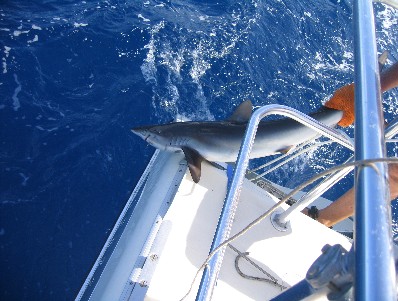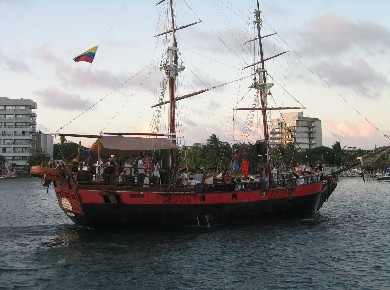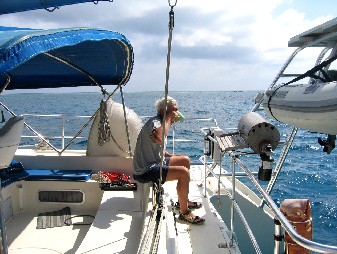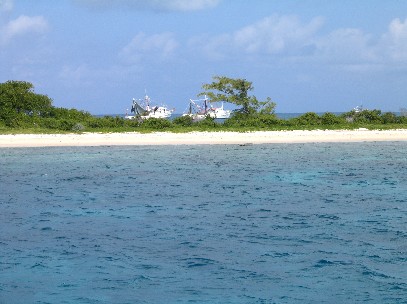15 February 2005
Isla de San Andres, Cayos Vivorillo, La Ceiba N15.4741 W 86.4537
If it's Tuesday, this must be Belgium
Shark, Shark. These wily  creatures populate every part of the ocean and if someone tells you there are no sharks in these waters the only thing you can be sure of is that it's not salt water. The shark's acute sense of smell attracts them to prey and they are most interested in prey that is already in distress. Well, wily or not we found one that hit on our favorite plastic lure. It took Rene almost forty minutes to reel it in. The fight left her exhausted and her arm sore. Okay so now what? Here's this "huge " and I might add stupid, predator thrashing on the side of the boat with my favorite lure hooked into the side of its jaw. We pour about a quart of alcohol into its gills. This technique is used to anesthetize the fish so that I can remove the lure. Yeah right . After another half hour of struggling, the shark is quite and I approach it with my filet knife. I can see my efforts to retrieve the lure will be a futile since it is behind the bony jaw. Suddenly, BAM, the shark lurched at me, its jaws snapping and slashing. I am certain this vicious attack is directed at me personally. The knife blade broke in half and I am up the transom in one leap. Hey, I can buy a new lure. Eventually we gave up the fight for the lure and let the shark swim away. creatures populate every part of the ocean and if someone tells you there are no sharks in these waters the only thing you can be sure of is that it's not salt water. The shark's acute sense of smell attracts them to prey and they are most interested in prey that is already in distress. Well, wily or not we found one that hit on our favorite plastic lure. It took Rene almost forty minutes to reel it in. The fight left her exhausted and her arm sore. Okay so now what? Here's this "huge " and I might add stupid, predator thrashing on the side of the boat with my favorite lure hooked into the side of its jaw. We pour about a quart of alcohol into its gills. This technique is used to anesthetize the fish so that I can remove the lure. Yeah right . After another half hour of struggling, the shark is quite and I approach it with my filet knife. I can see my efforts to retrieve the lure will be a futile since it is behind the bony jaw. Suddenly, BAM, the shark lurched at me, its jaws snapping and slashing. I am certain this vicious attack is directed at me personally. The knife blade broke in half and I am up the transom in one leap. Hey, I can buy a new lure. Eventually we gave up the fight for the lure and let the shark swim away.
San Andres is a party island for well-to-do Colombians. When we arrived we spotted only one other cruising boat and a few fishing boats. We anchored in front of the dock at Club Nautico (not affiliated with the Club Nautico in Cartagena) and spent two day s enjoying and exploring the island. But first a little about the trip. After spending three months at a dock you forget what it's like to sail and when we took off we found 28 knot winds and 8 foot seas for the first three hours. Now that will get you back in the groove quickly or make you a little queasy. The winds let up to 25 and the seas settled down to 4 to 6 feet plus we had a bit of a current pushing us. We were making 8 plus knots. In fact we thought we would have a 200 mile day for the first 24 hours. This is a benchmark for sailboats and is a sure indication that you are "hauling ass" no matter what size boat you are in. Only boats in the 80 plus foot range can maintain a 200 miles a day average, so you can see we were racing along. We ended up at about 180 miles, still not bad for an over stocked cruising boat with a short mast. We estimated the trip at three days and we made it in two and a half putting us near port at 8 at night. We hove-to about eight miles offshore and drifted another ten during the hours of darkness. In the morning we motored to the anchorage and tucked in between the reef and the island.. s enjoying and exploring the island. But first a little about the trip. After spending three months at a dock you forget what it's like to sail and when we took off we found 28 knot winds and 8 foot seas for the first three hours. Now that will get you back in the groove quickly or make you a little queasy. The winds let up to 25 and the seas settled down to 4 to 6 feet plus we had a bit of a current pushing us. We were making 8 plus knots. In fact we thought we would have a 200 mile day for the first 24 hours. This is a benchmark for sailboats and is a sure indication that you are "hauling ass" no matter what size boat you are in. Only boats in the 80 plus foot range can maintain a 200 miles a day average, so you can see we were racing along. We ended up at about 180 miles, still not bad for an over stocked cruising boat with a short mast. We estimated the trip at three days and we made it in two and a half putting us near port at 8 at night. We hove-to about eight miles offshore and drifted another ten during the hours of darkness. In the morning we motored to the anchorage and tucked in between the reef and the island..
If you ever wondered where your drug money went, well a portion of it is here in San Andres. Colombians holiday on this lovely island to escape the colder climates in the highland and sometimes to escape hectic Carnival activities back home. This week it was Carnival in Blanquilla and the island was full of visitors from that coastal Colombian city enjoying a few days off. While visiting the island, tourists find the party boats a popular attractions. Several times a day these boats load up, well beyond US Coast Guard standards, and head out to a tiny island where those aboard can take a short swim. The adventure takes two or three hours but during our stay the trip was extended a few minutes since the captains enjoyed circling Shira z once or twice. All the boats were outfitted with large sound systems banging away with Bob Marley or other island music. The passengers would wave to us as we were enjoying our sundowners in the cockpit. The brigantine, Captain Morgan was outfitted with dancing entertainment as you can see in the photo. z once or twice. All the boats were outfitted with large sound systems banging away with Bob Marley or other island music. The passengers would wave to us as we were enjoying our sundowners in the cockpit. The brigantine, Captain Morgan was outfitted with dancing entertainment as you can see in the photo.
These islands along with most of the islands that surround coastal Central America were settled by British colonists or British pirates and the native language is English. On this island however the tourist trade is primarily Colombian so the predominate language is Spanish. After a few days of relaxing and shopping duty free, we hoisted sail for an uninhabited archipelago, the Vivorillo Islands. It was a beat all the way and we tacked and tacked into head winds of 22 knots. Upon arriving we found the Honduran shrimp fleet anchored around the small islands protected by the coral reef. We had encountered shrimp boats on the night passages as we got closer to Vivorillo and when we arrived late in the afternoon there were twenty or more boats at anchor. It was time for the "factory boat" to meet the fleet and load the catch for the trip to port. After we anchored we were visited by Anthony and Lydia who live on a small neighboring island during the fishing season and in their small launch dove for lobster, collected conch, and caught fish to sell to the factory boat. This idyllic setting was spoiled by the flies that showed up every time we tried to cook something. Anthony explained that the shrimpers often get fish and shark in their nets. The sharks are shot immediatel y to save damage to the net and the fish are processed but the offal is not dumped overboard for fear of attracting more sharks and therefore more damage to the nets. Instead the remains are hauled off to the small island and dumped, thereby attracting a great number of flies. We were told that the problem exacerbates at the end of the month so any thought of hanging around was quickly dispelled and we had the anchor up the next morning headed for La Ceiba. During the first nights passage we again encountered the shrimp fleet.. At one time we could see the lights of ten boats in the surrounding water. The trick is to tell which direction and approximately how close they were. Rene did a wonderful job as I was down below sleeping to prepare myself to the midnight to six am shift. y to save damage to the net and the fish are processed but the offal is not dumped overboard for fear of attracting more sharks and therefore more damage to the nets. Instead the remains are hauled off to the small island and dumped, thereby attracting a great number of flies. We were told that the problem exacerbates at the end of the month so any thought of hanging around was quickly dispelled and we had the anchor up the next morning headed for La Ceiba. During the first nights passage we again encountered the shrimp fleet.. At one time we could see the lights of ten boats in the surrounding water. The trick is to tell which direction and approximately how close they were. Rene did a wonderful job as I was down below sleeping to prepare myself to the midnight to six am shift.
Just for a little perspective. In the last fifteen days we have covered more sea miles then we had in the last eighteen months. Is this Tuesday? Are we in Belgium?
Back Next
|